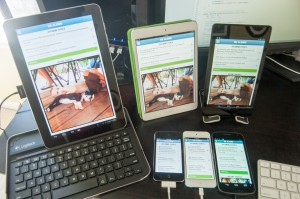Anne Hole, a member of the Sussex TEL team, was one of over 400 delegates at the Association for Learning Technology’s ‘Riding Giants’ conference this week. This is her report.
This was a huge conference so this post is just scratching the surface – fortunately you can see more for yourself by watching the recorded sessions on YouTube, including two inspiring and poetic keynotes from Catherine Cronin and Audrey Watters.
Learning technology coming of age
This was the 21st ALT conference and in his introduction, Joe Wilson, co-chair of the conference suggested that learning technology has now ‘come of age’ and is integral to education. This idea of learning technology ‘coming of age’, and what that might mean, became one of the themes of the conference for me.
Jeff Haywood, looked to the future in his opening keynote (Designing University Education for 2025: balancing competing priorities) but was of the view that at the moment the majority of technology used for learning at university is owned by students. If that is true – and I suspect that by ‘technology’ he meant ‘devices’ – then that should make us think what we mean if we use terms like ‘Digital University’ (a concept explored later by Sheila Macneill and Keith Smyth).
Where are we and what’s important?
One way of assessing the development of learning technology within HE is through the UCISA survey of Technology Enhanced Learning (TEL) which is carried out every 2 years. The results of the March 2014 survey were presented at the conference.
The most significant factor encouraging the development of TEL was found to be feedback from students, while lack of time and lack of knowledge amongst academic staff were identified as the leading barriers to TEL development.
In terms of the demands on TEL support teams, mobile technologies were found to be the most significant. MOOCs, which are often a big talking point at TEL gatherings, were considered by survey respondents not to pose a significant challenge.

creative commons licensed (BY-NC-ND) flickr photo by Adam Tuttle: http://flickr.com/photos/tuttletree/9688255220
Support for mobile learning
Bearing out the UCISA survey findings, there were several papers on support for mobile learning and two in particular I think will be of interest to readers:
Marion Kelt from Glasgow Caledonian University talked about the work she has done recreating a set of resources on Information Literacy so that they are fully accessible on mobile devices (SMIRK). This is an important consideration for anyone creating learning resources. We want students to be able to get the most from the materials we produce using the devices they want to use.
Matt Cornock and Blayn Parkinson presented their Reading on Screen resource which was produced in response to feedback from students at the University of York. You can read more about this in their blog post where they discuss the importance of avoiding assumptions about students’ confidence when reading documents on screen. The Reading on Screen website and associated Quick Guide are certainly resources that I will be bookmarking for future use!
Community
One of the best aspects of the conference was the opportunity to meet in person, colleagues who I have collaborated with online or engaged with using social media. Twitter was well-used over the 3 days and the #altc hashtag allowed for sharing of ideas, opinions, tips and tools. I have also added many new connections to my Personal / Professional Learning Network which will continue to develop my learning for years to come.
As a community of learning technology practitioners coming together we were able to share our stories about not only our successes but the bumps along the road as well.
Has learning technology come of age?
The UCISA survey indicated that learning technologies are still often seen as enhancements to courses rather than an integral part of the curriculum. We shouldn’t be surprised that mobile learning and Virtual Learning Environments (such as Study Direct) are not yet as normalized as pen, paper and books – each of which were revolutionary technologies in their time. The average 21-year-old hasn’t reached their full potential either. If the wealth of exciting ideas and enthusiastic practitioners at ALT-C 2014 is anything to go by, ALT may have ‘come of age’ but you have barely seen the beginning of what TEL can do!
If you are a member of teaching staff at the University of Sussex and would like to talk about how learning technology can be used to support your students’ learning please contact tel@sussex.ac.uk or the liaison learning technologist for your school.



